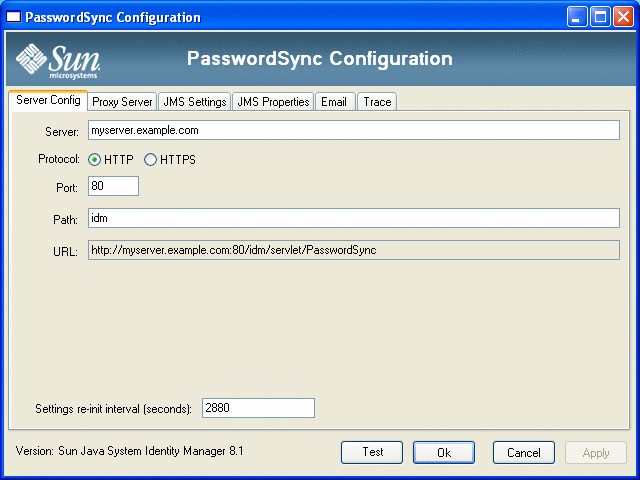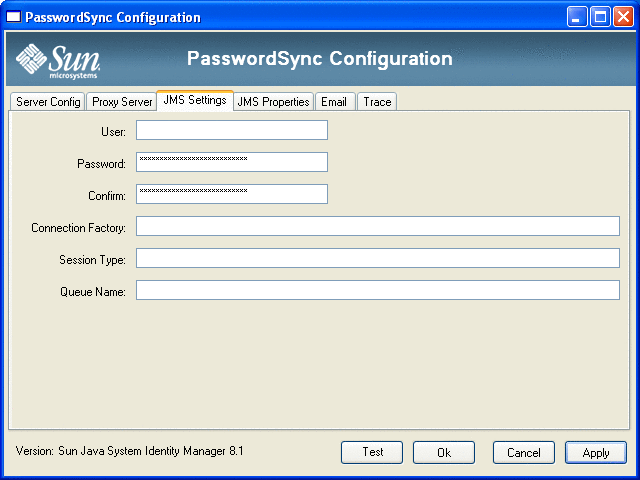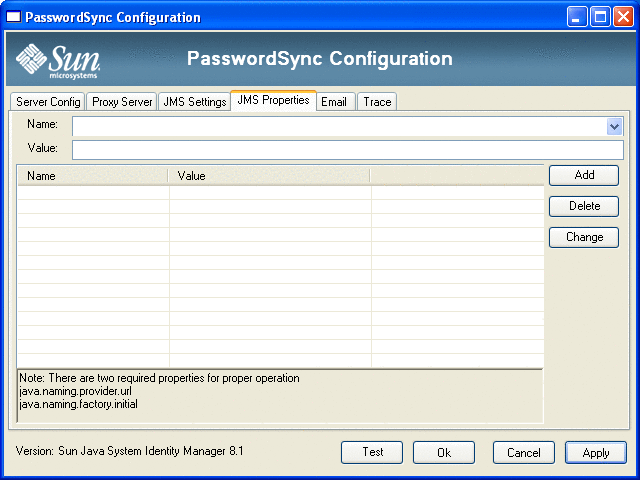 To Configure PasswordSync
To Configure PasswordSync
If you run the configuration application from the installer, the application displays the configuration screens as a wizard. After you have completed the wizard, each subsequent time you run the PasswordSync configuration application, you can navigate between screens by selecting a tab.
-
Start the PasswordSync configuration application (if it is not already running).
By default, the configuration application is installed at Program Files -> Sun Identity Manager PasswordSync -> Configuration.
Note –If you do not plan to use JMS, launch the configuration application from a command line, being sure to include the -direct flag as follows:
C:\InstallDir\Configure.exe -direct
The PasswordSync Configuration wizard dialog is displayed (see Figure 11–4).
Figure 11–4 PasswordSync Configuration Wizard

-
Edit the fields on this dialog as necessary.
These fields include:
-
Server must be replaced with the fully-qualified host name or IP address where Identity Manager is installed.
-
Protocol indicate whether to make secure connections to Identity Manager.
PasswordSync supports the configuration of certificate check behavior for HTTPS connections. When you enable HTTPS, the following options display:
-
Allow revoked certificates. This setting maps to the securityIgnoreCertRevoke registry value on the connection. By default, PasswordSync does not ignore revocation issues and the securityIgnoreCertRevoke registry value is set to 0.
If you want PasswordSync to ignore revoked certificate messages, check this box (or set the SECURITY_FLAG_IGNORE_REVOCATION registry value to 1).
-
Allow invalid certificates. This setting affects the SECURITY_FLAG_IGNORE_CERT_CN_INVALID, SECURITY_FLAG_IGNORE_CERT_DATE_INVALID, and SECURITY_FLAG_IGNORE_UNKNOWN_CA options on the connection. By default, PasswordSync does not allow invalid certificates and the registry values are set to 0.
Checking this box, or setting the securityAllowInvalidCert registry value to 1, allows PasswordSync to use certificates that do not pass a number of safety checks. Enabling this option is not recommended for a production environment.
Note –These settings are not displayed for the HTTP protocol type, nor do they affect HTTP settings.
-
-
Port specify an available port for the server. For HTTP, the default port is 80. For HTTPS, the default port is 443.
-
Path specify the path to Identity Manager on the application server.
-
URL is generated by concatenating the other fields together. The value cannot be edited within the URL field.
-
Settings re-init interval (seconds) specify how often the PasswordSync dll should reread configuration settings from the registry. The default value is 2880 seconds or 8 hours.
Note –This PasswordSync Configuration wizard displays the value in seconds, but the registry value is actually stored in milliseconds.
The PasswordSync dll reads the configuration settings from the registry while the dll is active. This interval value is stored in the reinitIntervalMilli registry value.
Passwords cannot be synchronized while the settings are being updated, which can cause a small delay in processing a password change. Normally this delay is less than a second. PasswordSync processes any password changes received during an update directly after the update has completed. Also, PasswordSync does not process setting updates while a password synchronization is in progress. The update will be rescheduled and performed at a later time.
-
-
Click Next to display the Proxy Server Configuration page (Figure 11–5) and edit the fields as needed.
Figure 11–5 PasswordSync Wizard Proxy Server Dialog

These fields include:
-
Enable. Select if a proxy server is required.
-
Server. You must enter the fully-qualified host name or IP address of the proxy server.
-
Port. Specify an available port number for the server. (The default proxy port is 8080 and the default HTTPS port is 443.)
-
-
Click Next.
Figure 11–6 PasswordSync Wizard JMS Settings Dialog

When the JMS Settings dialog (Figure 11–6) appears, perform one of the following actions:
-
Edit the following fields, as needed:
-
User specifies the JMS user name that places new messages on the queue.
-
Password and Confirm specify the password for the JMS user.
-
Connection Factory specifies the name of the JMS connection factory to be used. This factory must already exist on the JMS system.
-
In most cases, Session Type should be set to LOCAL, which indicates that a local session transaction will be used. The session will be committed after each message is received. Other possible values include AUTO, CLIENT, and DUPS_OK.
-
Queue Name specifies the Destination Lookup Name for the password synchronization events.
-
-
If you do not plan to use JMS and you launched the configuration wizard with the -direct flag, click Next to display the User dialog. Skip to step Figure 11–7.
-
-
Click Next to display the JMS Properties dialog (Figure 11–7).
Figure 11–7 PasswordSync Wizard JMS Properties Dialog

The JMS Properties dialog allows you to define the set of properties that are used to build the initial JNDI context. You must define the following name/value pairs:
-
java.naming.provider.url — Specify the URL of the machine running the JNDI service.
-
java.naming.factory.initial — Specify the classname (including the package) of the Initial Context Factory for the JNDI Service Provider.
The Name pull-down menu contains a list of classes from the java.naming package. Select a class or type in a class name, then enter its corresponding value in the Value field.
-
-
If you do not plan to use JMS and you launched the configuration wizard with the -direct flag, configure the User tab. Otherwise, skip this step and go to the next step.
To configure the User tab, edit the fields as necessary.
-
Account ID. Specify the user name that will be used to connect to Identity Manager.
-
Password. Specify the password that will be used to connect to Identity Manager.
-
-
Click Next to display the Email dialog (Figure 11–8) and edit the fields as necessary.
Figure 11–8 PasswordSync Wizard Email Dialog

To send an email notification when a user’s password change does not synchronize successfully due to a communication error or other error outside of Identity Manager, use the following options on the Email dialog to set up the notification and configure the email.
-
Enable Email. Select to enable this feature.
-
Email End User. Select if the user is to receive notifications. Otherwise, only the administrator will be notified.
-
SMTP Server. Enter the fully qualified name or IP address of the SMTP server to be used when sending failure notifications.
-
Administrator Email Address. Enter the email address where you want to send the notifications.
-
Sender’s Name. Enter the sender's “friendly name.”
-
Sender’s Address. Enter the sender's email address.
-
Message Subject. Enter the subject line for all notifications
-
Message Body. Enter the text for the notification.
The message body might contain the following variables:
-
$(accountId) — The accountId of the user attempting to change password.
-
$(sourceEndpoint) — The host name of the domain controller where the password notifier is installed, to help locate troubled machines.
-
$(errorMessage) — The error message that describes the error that has occurred.
-
-
-
Click the Trace tab Figure 11–9.
Figure 11–9 Trace Tab

Set the following fields.
-
Trace Level.
-
Max File Size (MB).
-
Trace File.
-
-
Click Finish to save your changes.
If you run the configuration application again, a set of tabs is displayed instead of a wizard. If you want to display the application as a wizard, type the following command from the command line:
C:\InstallDir\Configure.exe -wizard
To test your PasswordSync configuration, see Testing Your Configuration.
- © 2010, Oracle Corporation and/or its affiliates
